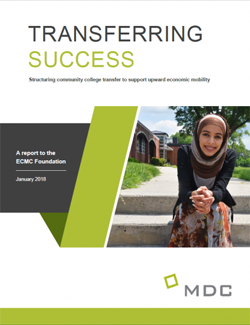Structuring Community College Transfer to Support Upward Economic Mobility
January 30, 2018
By MDC
In this report to the ECMC Foundation, MDC examines transfer practices and experiences at four Southern community colleges, observing how institutional practices, federal and state policies, and student mindset and behavior affect transfer students. Read the Report
Overview
Higher education is a cornerstone of civic and personal advancement in the United States, promising connections with knowledge, skills, and networks that can lead to high-paying work. This system boasts—but does not always deliver—equal opportunity to rise out of poverty and accumulate wealth and build economic security.
Across the country, however, states are struggling to reach goals for bachelor's degree completion and to improve stalled upward economic mobility, especially for those born into poverty. The problem is particularly stark in the South, where educational attainment lags national averages, income inequality is highest, and the odds of economic mobility are lowest. The chances of being stuck in the lowest income bracket decrease with a postsecondary credential.
Community colleges have long been important institutions for strengthening postsecondary attainment, awarding credentials that can lead to better paying jobs or form the foundation for additional credentials, including a bachelor's degree. With lower tuition costs and, ideally, an accessible pathway to a bachelor's degree via transfer to a four-year university, community colleges can still be launching-pad institutions that change the education and economic trajectory for individuals and families.
Recent research indicates, however, that ensuring successful student transfer and bachelor's degree attainment following transfer remains a challenge for both two-year and four-year institutions across the United States.
Project Goals
- Learn how four colleges are organizing their institutions to support successful transfer and development.
- Develop recommendations so philanthropic investors, policymakers, and practitioners to better understand their influence in strengthening or inhibiting institutional practices that propel students toward successful transfer and bachelor's degree completion.
Progress
We conducted interviews and focus groups with college administrators, faculty, staff, and students; reviewed print and online resources, state articulation agreements, transfer-related policies; and conducted an online survey of advising staff.
We reported our findings around four themes:
- Creating a transfer-supportive culture for transfer students.
- Communicating clearly and accurately.
- Enhancing cooperation between community colleges and four-year institutions.
- Structuring the student experience.
Lessons Learned
Our recommendations are:
- Frame transfer success as a tool for upward economic mobility. Have a clear transfer message and stay on message. Provide professional development about the transfer process that includes cross-training of all departments that play a part, no matter how small.
- Foster colleagueship across two-year and four-year institutions through planning together, making decisions together, and learning together. Face-to-face and shared professional development for faculty and advisors of two- and four-year institutions improves information sharing and establishes relationships that can help students facilitate relationships of their own. A two-way street for faculty becomes a smoother street for students.
- Involve students in the design of transfer pathways and supports. Ask the people who use the system how it really works—it may reveal surprising glitches or work-arounds that ought to become standard practice.
- Consider students' external experiences when designing internal transfer policies and programs. Evaluate how policies and practices—everything from to course maps to class schedules to lab requirements—may present barriers to students' enrollment decisions, taking care to consider external family and employment obligations.
- Measure what matters for your institution and your students. The complex nature of student transfer requires innovation. Consider indicators that take into account where students start with respect to academic factors and economic characteristics and how they progress over time.
Dig Deeper
For more information, contact Program Director Abby Parcell at aparcell@mdcinc.org.
Did you enjoy this grantee spotlight? Read more grantee spotlights here.

